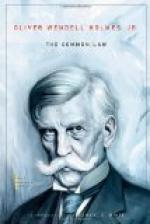81/1 See Lecture VII.
82/1 Austin, Jurisprudence (3d ed.), 440 et seq., 474, 484, Lect. XX., XXIV., XXV.
84/1 Lib. I. c. 2, ad fin.
85/1 Hist. English Law, I. 113 (bis), n.a; Id., ed. Finlason, I. 178, n. 1. Fitzherbert (N.B. 85, F.) says that in the vicontiel writ of trespass, which is not returnable into the king’s court, it shall not be said quare vi et armis. Cf. Ib. 86, H.
85/2 Milman v. Dolwell, 2 Camp. 378; Knapp v. Salsbury, 2 Camp. 500; Peafey v. Walter, 6 C.&P. 232; Hall v. Fearnley, 3 Q.B. 919.
85/3 Y.B. 6 Ed. IV. 7, pl. 18, A.D. 1466; cf. Ames, Cases in Tort, 69, for a translation, which has been followed for the most part.
87/1 Y.B. 21 Hen. VII. 27, pl. 5, A.D. 1506.
87/2 Cf. Bract., fol. 136 b. But cf. Stat. of Gloucester, 6 Ed. I. c. 9; Y.B. 2 Hen. IV. 18, pl. 8, by Thirning; Essays in Ang. Sax. Law, 276.
87/3 Hobart, 134, A.D. 1616.
87/4 Sir T. Jones, 205, A.D. 1682.
87/5 1 Strange, 596, A.D. 1723.
87/6 2 Keyes, 169, A.D. 1865.
88/1 Anonymous, Cro. Eliz. 10, A.D. 1582.
88/2 Sir T. Raym. 467, A.D. 1682.
88/3 Scott v. Shepherd, 2 Wm. B1. 892, A.D. 1773.
88/4 3 East, 593. See, further, Coleridge’s note to 3 Bl. Comm. 123; Saunders, Negligence, ch. 1, Section I; argument in Fletcher v. Rylands, 3 H.&C. 774, 783; Lord Cranworth, in S.C., L.R. 3 H. L. 330, 341.
90/1 Ex. gr. Metropolitan Railway Co. v. Jackson, 3 App. Cas. 193. See M’Manus v. Crickett, 1 East, 106, 108.
91/1 1 Ld. Raym. 38; S.C. Salk. 637; 4 Mod. 404; A.D. 1695.
92/1 2 Wm. Bl. 892. Cf. Clark v. Chambers, 3 Q.B.D. 327, 330, 338.
92/2 7 Vt, 62.
93/1 Smith v. London & South-Western Railway Co., L.R. 6 C.P. 14, 21. Cf. S.C., 5 id. 98, 103, 106.
93/2 Sharp v. Powell, L.R. 7 C.P. 253. Cf. Clark v. Chambers, 3 Q.B.D. 327, 336-338. Many American cases could be cited which carry the doctrine further. But it is desired to lay down no proposition which admits of controversy, and it is enough for the present purposes that Si home fait un loyal act, que apres devint illoyal, ceo est damnum sine injuria. Latch, 13. I purposely omit any discussion of the true rule of damages where it is once settled that a wrong has been done. The text regards only the tests by which it is decided whether a wrong has been done.
94/1 Mitchil v. Alestree, 1 Ventris, 295; S.C., 3 Keb. 650; 2 Lev. 172. Compare Hammack v. White, 11 C.B. N.S. 588; infra, p. 158.
95/1 Harvey v. Dunlop, Hill & Denio, (Lalor,) 193.
95/2 See Lecture II. pp. 54, 55.
97/1 cf. Hobart v. Hagget, 3 Fairf. (Me.) 67.
98/1 See Bonomi v. Backhouse, El. Bl. & El. 622, Coleridge, J., at p. 640.
99/1 3 Levirtz, 87, A.D. 1681.
99/2 Compare the rule as to cattle in Y.B. 22 Edw. IV. 8, pl. 24, stated below, p. 118.




